Nerite snails come from the Neritdae family, and get their name from the Greek sea god: Nerites. And in my opinion, this name fits beautifully. Because they are gods at keeping all types of algae from taking over your tank.
And the best part? They only breed in brackish or saltwater. So you’ll never be overrun.
Nerites are typically my number one choice for snails in all my planted tanks, and generally they’re the first animal I introduce.
In this care guide, I’ll share with you the different types available, how you can create a healthy environment for them, and some key issues you need to watch out for.
Table of Contents
Care Overview
- Tank Size: 2-5 gallons per snail
- Temperature: 72°-78°F (22°-26°C)
- Ammonia/Nitrite: 0
- Nitrate: <30 ppm
- pH: 7.0-8.2
- GH: 5-8 dGH
- KH: 5-15 dKH
- Life span: 1-3 years
- Size: 1inch (2.5cm)
Nerite Snail Species Profile

One thing to remember: there is no one species of “nerite snail.”
Many different species of nerite snails are sold in the aquarium trade and all come from the Neritdae family. In the wild, they can be found along coastlines on the Atlantic, Indian and Pacific Oceans.
Most nerites live along coastlines where rivers empty into the ocean. They’re thought to migrate back and forth between salt and brackish water as they feed, grow and reproduce.
A few species live strictly in freshwater, but they’re very much in the minority.
Nerites cling to things like rocks or mangrove roots in their natural habitats, where they graze on algae and biofilm.
All the different species are considered amphibious since they creep out of the water and breath while they’re above the waterline for several hours a day.
The cool thing is, they do this by carrying water with them in their shells. It makes me think of scuba gear or a spacesuit.
Different Types of Nerite Snails
One cool thing about nerites: there are a lot of different colors and patterns to choose from. Each species has its own unique look.
The patterns on individual snails might vary a bit from the norm. I really like this, no two are exactly the same, like human fingerprints.
Zebra Nerite Snails (Neritina natalensis)
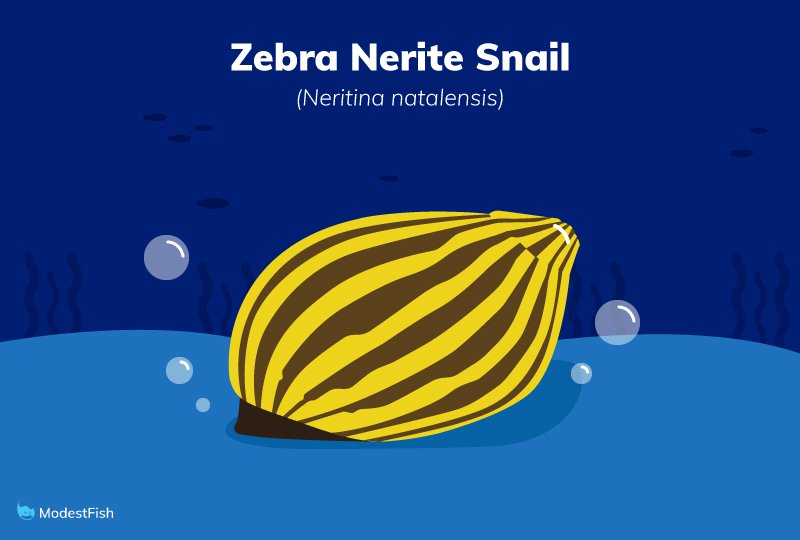
These little guys are a freshwater/brackish snail that have gold and dark brown stripes along their shells. Some have very thin stripes, almost like pinstripes. Others have much thicker stripes that may be more irregular. Some may even have rows of spots instead of full stripes.
No matter what, these snails are very striking and interesting to look at.
Tiger Nerite Snails (Vittina Semiconica)
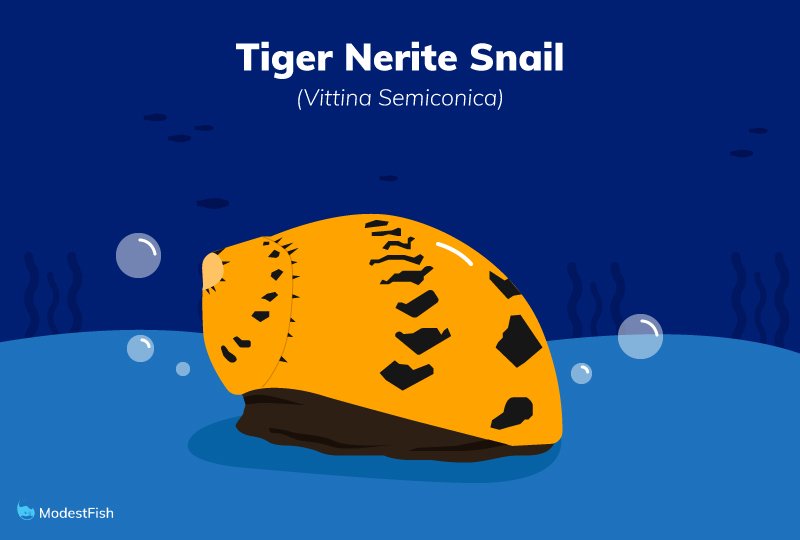
Tiger nerites are stunning. They’re a tiger-ish (should that be a word?) orange color with a lighter orange stripe that spirals around the shell. Small chevrons of dark brown follow along the light orange stripe. They look like tire marks to me.
Tigers can be kept in fresh or brackish water.
Olive Nerite Snails (Neritina reclivata)
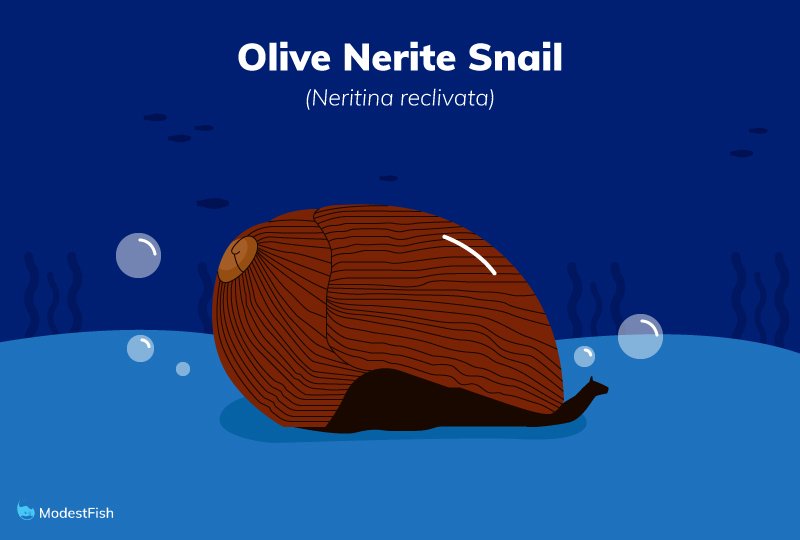
Olive nerites are found in salt, fresh and brackish waters. Just like the name implies, they’re olive green. They really look like martini olives to me.
Just don’t skewer them and put them in drinks. Your guests would not approve.
But seriously, their color lets them blend with plants and algae in the wild.
They look solid green, but if you get close enough you can see that their green color is made up of hundreds of tiny stripes, they look like growth rings on a tree.
Horned Nerite Snails (Clithon corona/diadema)
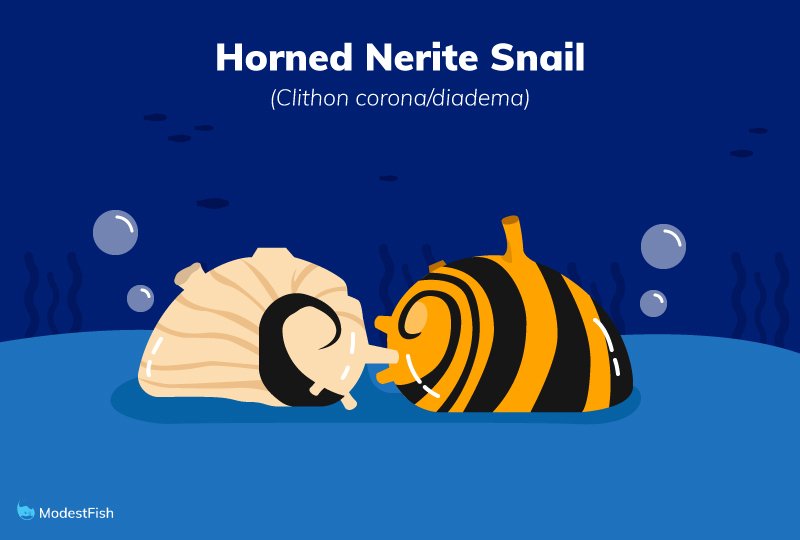
There are several species that are sold under the common name “horned nerite.” Their name comes from small thorn-like projections that grow out of their shells.
The horns look a lot like antennas. Maybe they’re trying to improve their Wi-Fi signal.
They come in many different colors and patterns. You can sometimes find a black and yellow variety (sold as the zebra horn nerite) that is just gorgeous. If you just want something a bit more unusual for your tank, they are the way to go.
Red Racer Nerite Snails (Neritina vittina waigiensis)
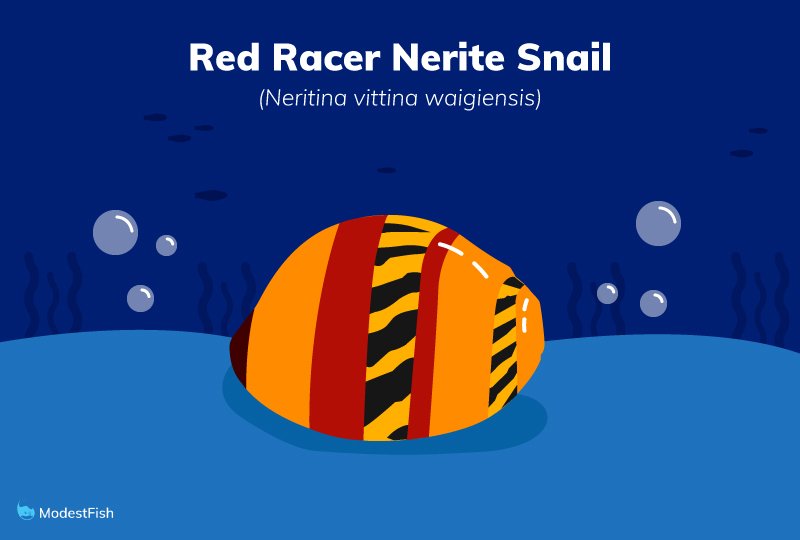
Red racers can be acclimated to salt or brackish water. There is a LOT of variety when it comes to their color pattern. Their base color is red and they can have stripes of light orange. They also have stripes of dark chevrons that look like tire marks that spiral over their shells.
Some may be mostly red with small stripes of chevrons. Others may have their whole shells taken up with chevrons. You never know what you’re going to get. These are a little harder to get a hold of, but they are gorgeous.
They do well in marine tanks and are reef safe.
Checkered Nerite Snail (Nerita tessellata)
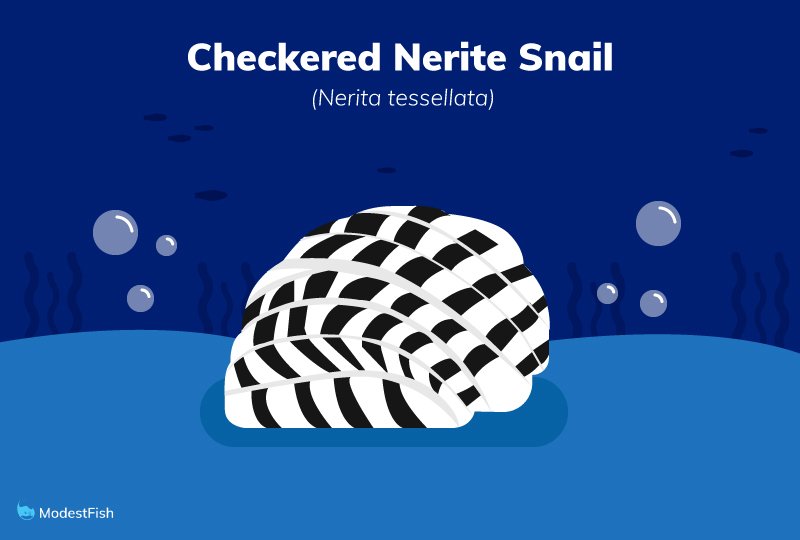
Checkered nerites are a marine species that has a distinctive pattern of black and white spots. They remind me of the checkerboard Vans shoes from the 80s. (Anyone too young to get the reference: hush, the adults are talking. Just kidding!)
They are reef safe and will happily eat all kinds of marine algaes and cyanobacteria. They can tolerate brackish water but not freshwater.
Aquarium Care For Nerite Snails
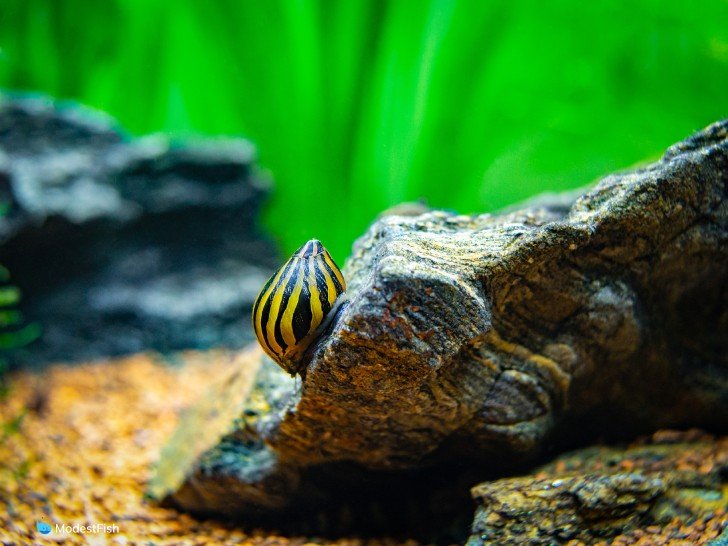
Water Parameters
- Temperature: 72°-78°F (22°-26°C)
- Ammonia/Nitrite: 0
- Nitrate: <30 ppm
- pH: 7.0-8.2
- GH: 5-8 dGH
- KH: 5-15 dKH
Water hardness is critical to a nerite snail’s health. They draw calcium from the water in order to grow their shells.
Water that is too acidic, or too soft, will break down their shells over time. The shells eventually start to get brittle and even develop holes in them.
Ultimately, this will kill the snail.
So make sure that you maintain a healthy pH, GH and KH to prevent this. Nerites are very sensitive to nitrates. So maintaining healthy parameters is key.
Keeping up with your water changes goes a long way towards keeping your fish and invertebrates happy and healthy, especially sensitive species like nerites.
Pro Tip: Most species of nerites won’t be able to handle temperatures over 78°F (26°C), so they may not be compatible with fish like Discus. Research the species so you know if it is a good fit for your tank.
Tank Size
Personally, I don’t keep nerites in tanks smaller than 5 gallons, because I don’t own any tanks smaller. And generally, I follow the rule of one nerite per 5 gallons. So if you have a 10 gallon, you should really only keep two in the tank.
In my experience, it ensures there is enough algae for them to feed on. However, you can keep nerites in tanks as small as 2-3 gallons, and as long as they have enough food available, they’ll do fine.
Tank Setup
Freshwater nerites are also escape artists that like to climb out of the tank and wander around the neighborhood. Make sure that your tank has a tight fitting lid and/or a large rim to keep snails from skipping town on you.
No need to worry if you have plants in the tank. Nerites will gently clean algae off of plant leaves but won’t eat the plant itself.
Nerites need a variety of dark hiding places to choose from. They’re not speedy creatures, so having to travel all the way across the tank every time they want to take a little snooze is too much to ask.
These little guys do best if there are lots of surfaces for them to crawl around on and feed off of. They like a tank with lots of plants, rocks and other decor.
Pro Tip: Just like in a marine tank, nerites need to be able to rest above the waterline. Make sure there is a gap between the surface of the water and the rim of the tank big enough for them to get themselves out of the water.
Feeding Nerite Snails

Nerite snails will mostly eat algae in your tank. They’re pretty darn efficient at it, which is pretty much the whole reason they’re so popular in the aquarium trade.
Sometimes, they’re so good at it that they hoover the entire tank clean and there’s not enough algae left.
But don’t worry, you can supplement their diet with algae wafers. If you’re only trying to feed one or two snails, you can break the wafer into quarters and put a smaller portion in the tank.
You just have to make sure that the wafer gets eaten. Uneaten algae wafers will eventually break down in the tank.
In my experience, rotting algae wafers tend to sprout saprolegnia, not something you want popping up all over your tank.
Pro Tip: Always place algae wafers where it’s easy to observe them. If the wafer doesn’t get eaten, this makes it easier to find it and remove it later. Waterlogged wafers can be sucked out with a gravel vacuum.
Snails also appreciate blanched veggies like carrots, zucchini or cucumber.
You can also cook up some snail jello (doesn’t that just sound tasty?). It’s easy to make, easy to portion out and doesn’t break down in the water as quickly as algae wafers.
In Tank Behavior & Tank Mates
Nerites are really peaceful and don’t really bother anyone.
They’re the peaceful hippies of the aquarium who just munch algae salad and talk about how love can unite the universe, man.
But seriously, they are completely non-aggressive. They can be kept with any peaceful community fish, ornamental shrimp and/or other snails (except assassins!).
Just don’t put them with large, aggressive fish. Aggressive fish may try to turn your nerites into dinner or bite their antennas off.
Even if they can’t eat the whole snail, they can take bites out of the poor thing and seriously hurt it.
Watch out, some species of fish specialize in eating snails, like botia loaches. They are stone cold killers when it comes to snails.
They will harass and nip snails and do their best to pull them out of their shells. It’s brutal.
Breeding Nerite Snails
You’ll read all over the internet that nerites do not readily breed under most aquarium conditions.
Well, that’s not entirely true. If you have a male and female nerite, they will breed and lay eggs all over the tank, in salt or freshwater.
But, unless you have a brackish tank, the baby snails won’t hatch.
So, in fresh or saltwater, you won’t end up with a billion unwanted snail babies.
Many species of snail can reproduce asexually, but this isn’t the case with nerites. You need both sexes for them to breed.
It’s thought that, in the wild, nerites travel back and forth between fresh, salt and brackish waters in order to grow, eat and reproduce.
Honestly, most people who end up breeding nerites, do it by accident. But you might be able to pull it off if you create the right tank conditions.
If you’d like to take a whack at it, set up and cycle a brackish tank with a specific gravity between 1.005 and 1.010. If you put six snails in the tank, more than likely you’ll have at least one male and one female.
The snails will mate, and the female will lay small clutches of eggs on the glass and decor in the tank.
The eggs hatch into free swimming larvae. Because of this, you’ll need to either use a sponge filter in the tank or use a sponge pre-filter. As they mature, the larvae begin to develop shells and start to resemble snails.
They’ll switch over to crawling instead of swimming in the open water.
Solving Common Problems with Nerite Snails
Here are some common problems aquarist’s have when caring for Nerite Snails
Missing Antennas
Nippy or aggressive fish can bite off a snails antennas. Try to keep an eye on the tank and move either the snails, or the fish, if it looks like the snail is getting beat up.
Shunted Shell Growth
Nerites can run into problems that cause their shells to stop growing.
- There are two main causes for this:
- Water temperature is kept too low.
- Snail does not have enough to eat.
Make sure your tank stays above 72°F (22°C) so your snails can maintain their metabolism.
If you don’t see any visible signs of algae in your tank, supplement your nerite’s diet.
Shell Deterioration
Sometimes a nerite’s shell will develop cracks or holes.
If it’s a young snail, most likely this is because the water is too soft and acidic. Under these conditions, the water leaches calcium out of the shell, sometimes until it is completely eaten away in some places.
Make sure that your water has an appropriate GH and pH. This will ensure that the water isn’t eroding the shell.
You can also offer calcium rich foods like spinach or broccoli, or maybe a piece of cuttlebone. This helps ensure the snails have the calcium they need to build new shell as they grow.
If it’s an older snail, this may simply be age. Old snails start to develop holes in their shells towards the end of their lives. So the snail may simply be deteriorating due to old age.
Growth Deformities
Snails can develop growth deformities in their shells when part of the shell grows more slowly than other parts.
This can lead to big grooves or even large holes in the shell, sometimes even exposing the snail’s body underneath. Growth deformities are most often caused by injuries to the snail’s mantle, the organ in the body that creates new shell.
What to Look for When Buying Nerite Snails
I always try to pick out the snails that are actively roaming around the tank and eating. It’s fairly safe to assume that the active ones are pretty healthy.
But sometimes, you get there and everybody is taking a little snooze. It’s totally OK if the snails in the tank seem to be just holding still at the surface of the water.
They’re just taking a little rest and drying out a little bit. No big deal.
But do not buy any snail that is laying at the bottom of the tank, sucked into its shell. This is not normal behavior and indicates that the snail is sick and/or dying.
It’s also best to skip any snail that has holes in its shell. This means it hasn’t been getting enough calcium or that it’s really old.
Either way, the shell is already brittle and eroding, so go with a different one.
Are Nerite Snails Right for You?
Nerite snails really need water that has a high pH and mineral content. If you have soft acidic water, you would need to use products to add calcium to your water and increase the KH and pH.
These little guys prefer tanks that have a lot of plants and decor so they have plenty of surfaces to feed off of and several choices for hidey holes. They wouldn’t be happy long term in a bare tank.
It’s a good idea to monitor algae levels in your aquarium. If you still see algae growing in the tank, you’re good to go.
But if the tank looks super clean, it’s time to offer your snails some lunch, or you risk them developing shell problems or starving to death.
Nerites are super peaceful. You have to worry more about them getting picked on than the nerites being aggressive towards a tankmate.
They don’t fight amongst themselves so you can keep as many as your tank can support.
Overall, nerites are really easy to take care of and I highly recommend them. They are little algae vacuum cleaners and they’re really cool to look.
That’s a win all around.

Hello! thanks for all the information, it has been super helpful to me to read it all in one place. 🙂
Hi , thanks for all u r information, it will help me a lot .
Hi, I have soft water. Gh 7, kh 3, ph 7.2
What is the best way to raise these? I have argonite will that do or crushed egg shell is an option but not sure how much to dose. This would be in a 3gal. cube with anubias nana, narrow leaf chain sword, & java moss. Other occupants are ghost shrimp & a betta.
Hi Holly, limestone-based rocks or crushed coral are options for raising hardness